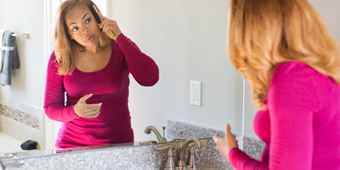What Every Woman Needs To Know About Incontinence

Answer a few questions and we'll provide you with a list of primary care providers that best fit your needs.
Do you find yourself sprinting for the bathroom? Wondering why you “leak” sometimes? Millions of women will experience some type of incontinence in their lifetime. Whether it’s a minor nuisance or seriously affects your daily quality of life, here’s what you need to know.
Urinary incontinence is the inability to control the release of urine.
What Is Urinary Incontinence?
Urinary incontinence is the inability to control the release of urine. It may mean that you leak urine, or that you cannot hold it until you can get to a bathroom. If you’re like some women, you may lose just a few drops of urine while laughing or coughing. Others may feel a strong and sudden urge to urinate just before losing a large amount of urine.
What Are the Different Types Of Urinary Incontinence?
- Stress incontinence. If you experience loss of urine when you cough, sneeze, laugh or exercise, you may have stress urinary incontinence (SUI). It’s caused by weak muscles under the bladder. Childbirth can also trigger incontinence because of the increased weight pushing on your pelvic floor. Some women experience leakage only occasionally — when they exercise hard or just have a very full bladder. Others may be troubled by frequent leakage when they do something as simple as walking or getting out of a chair.
- Urge incontinence. Also called an overactive bladder, urge incontinence means your bladder feels full even when it’s almost empty. The main symptom is a sudden, uncontrollable need to urinate. Other symptoms: frequency (more than eight voids in 24 hours) and nocturia (waking up two or more times at night to urinate). It’s a common condition affecting millions of women. However, the cause remains unknown.
- Overflow incontinence. When the bladder is full, urine doesn't empty properly and may leak out in small amounts. Or the urge to urinate is felt frequently, but urine trickles instead of flowing freely. In fact, the bladder may never feel completely empty. Weak bladder muscles or a blocked urethra can cause this type of incontinence. Fortunately, overflow incontinence in women is rare.
- Mixed incontinence. This is when two or more causes contribute to urinary incontinence. Often, stress and urge incontinence occur together in women. For example, a woman may experience leaking with coughing, plus the need to get to a bathroom quickly. Mixed incontinence is the most common type of urine loss.
- Other types of incontinence. Functional incontinence results when something affects your ability to get to the bathroom quickly – for example, if you have arthritis or use a walker. A fistula, an abnormal connection between the vagina and urinary tract, is rare but can lead to urinary incontinence. With diverticulum, urine collects in a pouch within the urethra and dribbles out.
What Increases A Woman’s Risk Of Leaking Urine?
There are a variety of things, including lifestyle choices, that increase your chances of urinary incontinence. Physician assistant Elyse Weber, PA-C explains what you can do:
Click play to watch the video or read video transcript.
How Can Incontinence Be Managed?
Elyse Weber describes numerous ways that urinary incontinence can be significantly reduced or halted.
Click play to watch the video or read video transcript.
Answer a few questions and we'll provide you with a list of primary care providers that best fit your needs.
Source: 5/31/2012 American Urogynecologic Society; National Institutes of Heal; Elyse Weber, PA-C, Lifestages Centers for Women







